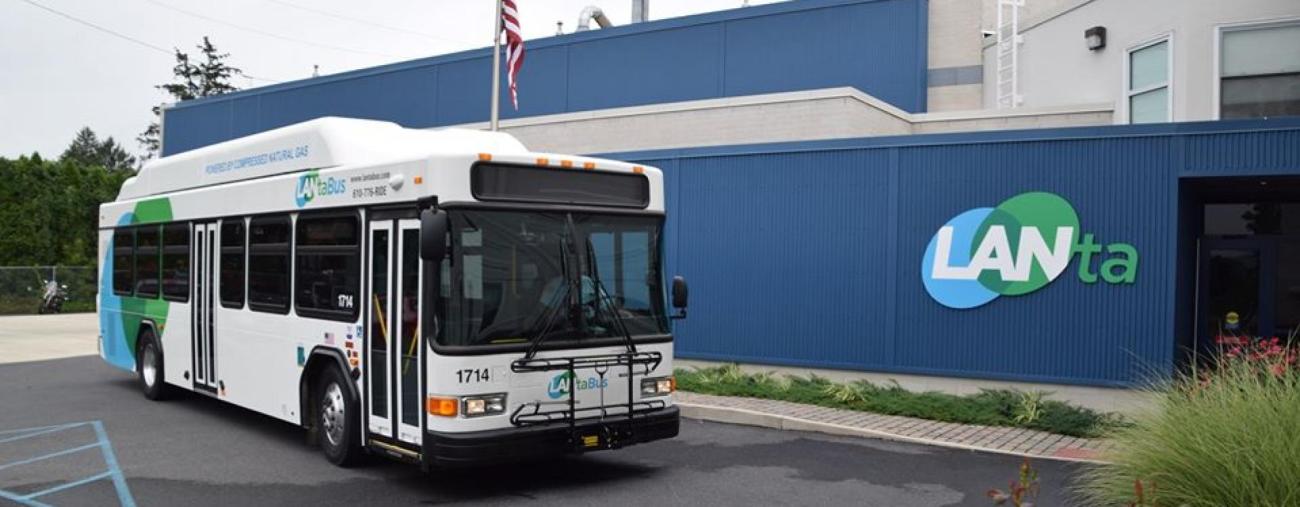Designing for Connection
Lehigh Students Reimagine Bus Access and Urban Equity in South Bethlehem
At the base of Bethlehem’s Fahy Bridge, nestled just behind a curtain of urban obscurity, lies a small triangle of green space that most passersby barely notice. But for Karen Beck Pooley and her environmental studies students, this unassuming patch of land—currently a little-known bus stop—has become a site for envisioning more equitable, accessible, and sustainable urban infrastructure.
Pooley, professor of practice in political science and the co-director of Lehigh’s Small Cities Lab, directed a community and economic development project in Fall 2024 that offered students a rare opportunity: reimagine public transit access at the intersection of policy, design, and lived experience. Collaborating with the Lehigh and Northampton Transportation Authority (LANTA), the City of Bethlehem, and South Side community organizations, students were asked to investigate a deceptively complex question — how do we make a bus stop visible, functional, and meaningful?
This site is tucked literally behind everything, Pooley notes. It sits in a park, at the edge of a dense urban area, and most Lehigh students don’t even know it exists. The dream for LANTA is to have express bus stops to service destinations such as the Lehigh Valley Mall and Lehigh Valley International Airport. So, they started to brainstorm, “Well, how do we design these bus stations?” Since the Fahy Bridge stop is closest to Lehigh, LANTA gave the students free rein to think about what kind of amenities would make sense here. At the heart of the initiative was a real-world design challenge. Students were not only asked to propose infrastructure improvements, but also to understand the human barriers that shape transit use — especially among those most in need of affordable transportation options.
Using fieldwork and interviews, students identified key deterrents to ridership, such as confusing pedestrian pathways and unsafe intersections. In some cases, students had to "hold their breath and run across Third Street," as Pooley described, just to reach the stop—an unprotected crossing that revealed the disconnect between transit potential and urban design.
Heidi Kline ’25G was part of a group focused on ways to better link the bus stop to the South Bethlehem Greenway. “Right now, it’s hard to even know it’s there unless someone is already standing at it," she says. To tackle the issue, Kline and her colleagues proposed a series of thoughtful, practical improvements. Drawing on personal observation, urbanist texts like those by Jane Jacobs, and extensive map work, the students identified key pathways—specifically Webster and Adams Streets—that could be enhanced to guide people safely from the Greenway to the bus stop.
Their recommendations included adding wayfinding signage—like the Greenway’s existing "one-minute to" signs—pointing toward the bus stop, installing new crosswalks at hazardous intersections like Webster and Columbia, and creating bike lanes along Webster Street. They also suggested placing stop signs to calm traffic and improve safety for pedestrians and cyclists.
"Crosswalks are a huge need. If you’re coming down Adams Street to the bus stop, there’s just no safe or legal place to cross,” Kline says.
“This work is about visibility. Not just of the bus stop, but of the people who need it most.”

The project also uncovered a gap in awareness — although Lehigh offers free bus passes to students, few were aware of the service. Public policy student Huda Hagos ’25G and finance major Nolan Forsyth ’25 focused on improving Lehigh’s internal transit communications. They found that most students didn’t know they could ride LANTA buses for free. To address this, they recommended engaging student groups, international organizations, and sustainability clubs to promote LANTA for everyday needs—from grocery runs to off-campus events. They also proposed integrating LANTA’s real-time tracking into the goLehigh app, making it as convenient to locate a LANTA bus as a campus shuttle. Additionally, they identified key stops—such as the Fahy Bridge—and mapped out popular routes to help students better navigate the system. Their broader goal is to build a long-term partnership between LANTA and Lehigh that reduces emissions and saves students money.
The class presented their ideas to representatives from LANTA, the City of Bethlehem, and the SouthSide Arts District. City officials reviewed student recommendations for improving the Columbia Street corridor and prioritized those that are both feasible and aligned with ongoing city initiatives. One major step already in motion is an engineering-led traffic study of Columbia Street, from Polk Street to the Fahy Bridge. This study was planned prior to the student-led Lehigh project, but it complements it well—especially given the students’ emphasis on adding traffic-calming measures along this stretch. The study will help determine which of these proposed improvements should move forward.
In the meantime, the city’s engineering department is also evaluating options for more visible crosswalks near the patch informally named Triangle Park. However, several ADA ramps in the area are currently obstructed, requiring a broader, more comprehensive approach to address accessibility challenges. Beyond infrastructure, the city’s planning department is collaborating with the SouthSide Arts District to identify grant opportunities aimed at enhancing the park — making it a more inviting space to sit, walk, and enjoy nature.
While these projects are still in the early stages, the city remains committed to keeping them on the radar and moving them forward in concert with community partners. Discussions are also underway to pilot certain improvements during Musikfest, when LANTA and the City hope to direct more users to the bus station. As Pooley sees it, this kind of university-community partnership exemplifies a shift in how Lehigh prepares students to think about public space: not as static, utilitarian infrastructure, but as dynamic civic terrain—shaped by policy, imagination, and justice.
“This work is about visibility,” she says. “Not just of the bus stop, but of the people who need it most.”

